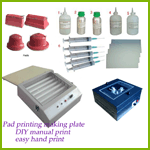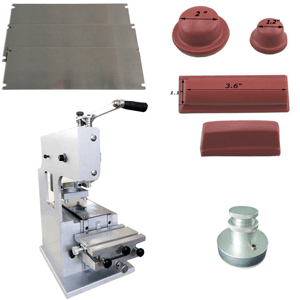|
|
|
Pad
printing making plate easy DIY plate |
|
Pad printing is a printing process that can transfer a 2-D image onto
a 3-D object. This is accomplished using an indirect offset (gravure) printing
process that involves an image being transferred from the printing
plate (cliché) via a silicone pad onto a substrate (surface to be
printed). Pad printing is used for printing on otherwise impossible
products in many industries including medical,
automotive, promotional, apparel, electronics, appliances, sports
equipment and toys. It can also be used to deposit functional materials
such as conductive
inks, adhesives, dyes and lubricants.

|
| Plate
making is vital import for pad printing, it
determines you printing quality, our this full set plate making
liquids and and machine can help you DIY you plate. |
| 1-Cleaning liquid
500ml /bottle(011036)
2-Photosensitive liquid 250ml
/bottle(011007)
3-Developing liquid 250ml
/bottle(011008)
4-Etching liquid 250ml
/bottle(011009)
5-Stripping liquid
500ml/bottle(011010)
6-5 syringes(001060)
7-5 pieces of thin steel plate
8-1/2x3-7/8 inch (011005)
cliché-making |
 |
|
|
UV Exposure Unit |
 |
ASC
10.2"x8.3"
exposure unit is an equipment used for
small area exposure, especially suitable for exposure
of small size plates
Parameters
Exposing area: 10.2"x8.3"(260x210mm)
Voltage: 110v
Time Range: 0-330 seconds
Light power: 48W(six 8W UV fluorescent bulbs )
Machine size: 12.6"x12.5"x4.3"(320x317x108mm)
Package dimensions: 14.6"x14.6"x5.5"(370x370x140mm)
Net weight: 8.4Lb(3.8kg)
Shipping weight: 10.6Lb(4.8kg) |
|
|
Emulsion Coating
Machine |
 |
Steel
plate coating machine can coat photosensitive liquid evenly
on surface of steel plate or steel blade by the
centrifugal effect caused by high-speed rotation. It is one of
the important equipments in the process of plate making
and a necessary tool for making high quality plate.
-
Coating by centrifugal rotation, even and flat.
-
With
special designed scale, it is easy to install steel plate,
which extraordinarily solve the departure in installing.
-
Collocated
with speed–adjustable motor, you can adjust speed of the
motor with potentiometer to control thickness of coating.
-
With
special designed “+”construction, it is more saving of
power and easy to clean.
-
Equipped
with handle and protection cover, it is safer to operate.
- Suitable steel
plate size:3.5"-8.66"(89-220mm)
- Machine size: 13.6"
X 13.6" X 7"(345x345x175mm)
- Net weight: 22LB(10KG)
- Shipping weight:
24LB(11KG)
|
|
|
How the process works
 |
Step 1: Flooding
The image to be
transferred is etched into a printing plate commonly
referred to as a cliche'. Once mounted in the machine, the
cliche' is flooded with ink. The surface of the cliche' is
then doctored clean, leaving ink only in the image area.
As solvents evaporate from the image area the ink's
ability to adhere to the silicone transfer pad increases.
|
 |
Step 2: Pick Up
The pad is positioned directly over the
cliche', pressed onto it to pick up the ink, and then
lifted away. The physical changes that take place in the
ink during flooding (and wiping) account for its ability
to leave the recessed engraving in favor of the pad.
|
 |
Step 3: Print Stroke
After the pad has lifted away from the
cliche' to its complete vertical height, there is a delay
before the ink is deposited on the substrate. During this
stage, the ink has just enough adhesion to stick to the
pad (it can easily be wiped off, yet it does not drip). The
ink on the pad surface once again undergoes physical
changes: solvents evaporate from the outer ink layer that
is exposed to the atmosphere, making it tackier and more
viscous.
|
 |
Step 4: Ink Deposit
The pad is pressed down onto the
substrate, conforming to its shape and depositing the ink
in the desired location. Even though it compresses
considerably during this step. a properly designed pad, in
fact, will never form a 0-degree contact angle with the
substrate; such a situation would trap air between the pad
and the part, resulting in an incomplete transfer.
|
 |
Step 5: Pad Release
The pad lifts away from the substrate
and assumes its original shape again, leaving all of the
ink on the substrate. The ink undergoes physical changes
during the head stroke and loses its affinity for the pad.
When the pad is pressed onto the substrate, the adhesion
between the ink and substrate is greater than the adhesion
between the ink and pad, resulting in a virtually complete
deposit of the ink. This leaves the pad clean and ready
for the next print cycle.
|
|
|
Items included:
1) 1 set of emulsion coating
machine (011003)
2) 1 set of 10.2"X8.3" UV exposure (010031)
3) 1 pc Silicone Rubber Pad L-2800 (011037)
4) 1 pc Silicone Rubber Pad L-2810 (011038)
5) 1 pc Silicone Rubber Pad R-0552 (011039)
6) 1 pc Silicone Rubber Pad R-0582 (011040)
7) 5 sheets cliché (011005)
8) 1 Cleaning liquid 500ml /bottle (011036)
9) 1 Photosensitive liquid 250ml /bottle(011007)
10) 1 Developing liquid 250ml /bottle(011008)
11) 1 Etching liquid 250ml /bottle(011009)
12) 1 Stripping liquid 500ml/bottle(011010)
13) 5 syringes(001060) |
|






